

Minnesota Grasshoppers and Crickets.
Eating Bugs. Nut Weevils. ENTFACT-206: Nut Weevils | Download PDF by Ric Bessin, Extension EntomologistUniversity of Kentucky College of Agriculture Nut weevils can be very serious pests of native and non-native nut trees.
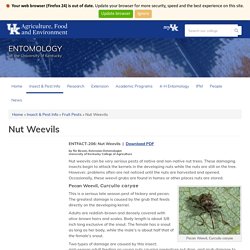
These damaging insects begin to attack the kernels in the developing nuts while the nuts are still on the tree. However, problems often are not noticed until the nuts are harvested and opened. Occasionally, these weevil grubs are found in homes or other places nuts are stored. Pecan Weevil, Curculio caryae Pecan Weevil, Curculio caryae This is a serious late season pest of hickory and pecan. Adults are reddish-brown and densely covered with olive-brown hairs and scales. Two types of damage are caused by this insect; mid-season adult feeding on young nuts causing premature nut drop, and grub damage to the kernels that usually occurs after shell hardening. Adults weevils emerge from the ground in late August through September, about the time nuts begin to harden.
Predatory ‘Glow Worm’ Discovered In Peruvian Rainforest. Different organisms are capable of glowing for various reasons.
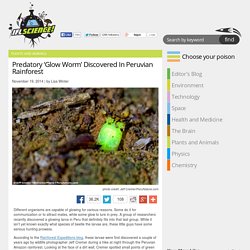
Some do it for communication or to attract mates, while some glow to lure in prey. A group of researchers recently discovered a glowing larva in Peru that definitely fits into that last group. While it isn’t yet known exactly what species of beetle the larvae are, these little guys have some serious hunting prowess. According to the Rainforest Expeditions blog, these larvae were first discovered a couple of years ago by wildlife photographer Jeff Cremer during a hike at night through the Peruvian Amazon rainforest. Looking at the face of a dirt wall, Cremer spotted small points of green light. Cremer returned to the rainforest alongside three entomologists: Aaron Pomerantz of Rainforest Expeditions, along with Pomerantz’s colleagues from the University of Florida, Mike Bentley and Geoff Gallice.
The scientists suspect that the larvae glow in order to draw in prey, then ambush them when they come close enough. A maggot to fly transformation. This incredibly gross but fascinating footage shows a maggot morphing into a fly.
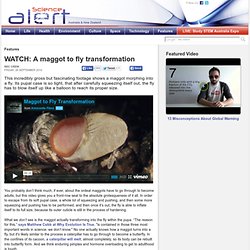
Its pupal case is so tight, that after carefully squeezing itself out, the fly has to blow itself up like a balloon to reach its proper size. You probably don’t think much, if ever, about the ordeal maggots have to go through to become adults, but this video gives you a front-row seat to the absolute grotesqueness of it all. Damselfly.
Dragonfly. Cicada Killers (Wasp) Cicada. Scutigera coleoptrata (house Centipede. Morphology[edit] Reproduction and development[edit] Behavior and ecology[edit] Closeup of the head showing modified legs In 1902, C.

L. It may often be seen darting across floors with very great speed, occasionally stopping suddenly and remaining absolutely motionless, presently to resume its rapid movements. Habitat[edit] Distribution[edit] Spiders of Minnesota. Of the 39 species found in our database, the following are established in Minnesota.
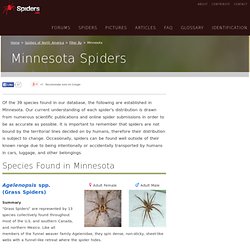
Our current understanding of each spider's distribution is drawn from numerous scientific publications and online spider submissions in order to be as accurate as possible. It is important to remember that spiders are not bound by the territorial lines decided on by humans, therefore their distribution is subject to change. Occasionally, spiders can be found well outside of their known range due to being intentionally or accidentally transported by humans in cars, luggage, and other belongings. Adult Male Adult Female Agelenopsis spp. Summary “Grass Spiders” are represented by 13 species collectively found throughout most of the U.S. and southern Canada, and northern Mexico. Image #2 of the bug Giant Silkworm Moth, Robin moth (Hyalophora cecropia) Giant weta (Giant Cricket) Giant weta tend to be less social and more passive than other weta.
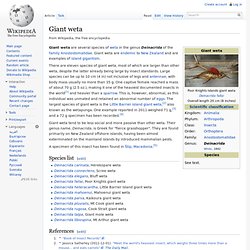
Their genus name, Deinacrida, is Greek for "fierce grasshopper". They are found primarily on New Zealand offshore islands, having been almost exterminated on the mainland islands by introduced mammalian pests. A specimen of this insect has been found in Štip, Macedonia.[5] Species list[edit] Rhaphidophoridae (Cave Cricket) Description[edit] Camel cricket Most cave crickets have very large hind legs with "drumstick-shaped" femora and equally long, thin tibiae, and long, slender antennae.

The antennae arise closely and next to each other on the head. They are brownish in color and rather humpbacked in appearance, always wingless, and up to two inches/5 cm long in body and 10 cm (4 inches) for the legs. The bodies of baby crickets may appear translucent. Their distinctive limbs and antennae serve a double purpose. Ladybugs. Identifying the 4 Most Common Ladybugs I.
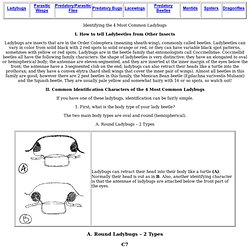
How to tell Ladybeetles from Other Insects Ladybugs are insects that are in the Order Coleoptera (meaning sheath-wing), commonly called beetles. Ladybeetles can vary in color from solid black with 2 red spots to solid orange or red, or they can have variable black spot patterns, sometimes with yellow or red spots. Ladybugs are in the beetle family that entomologists call Coccinellidae. Trombiculidae (Chiggers) Trombiculidae (/trɒmbɨˈkjuːlɨdiː/ (also called berry bugs, harvest mites, red bugs, scrub-itch mites and aoutas) are a family of mites.[3] The best known of the Trombiculidae are the chiggers.
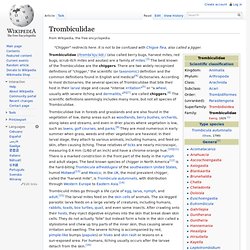
There are two widely recognized definitions of "chigger," the scientific (or taxonomic) definition and the common definitions found in English and medical[4] dictionaries. According to most dictionaries; the several species of Trombiculidae that bite their host in their larval stage and cause "intense irritation"[5] or "a wheal, usually with severe itching and dermatitis,"[6][7] are called chiggers.[8] The scientific definitions seemingly includes many more, but not all species of Trombiculidae.
After feeding on their hosts, the larvae drop to the ground and become nymphs, then mature into adults which have eight legs and are harmless to humans. In the postlarval stage, they are not parasitic and feed on plant materials.